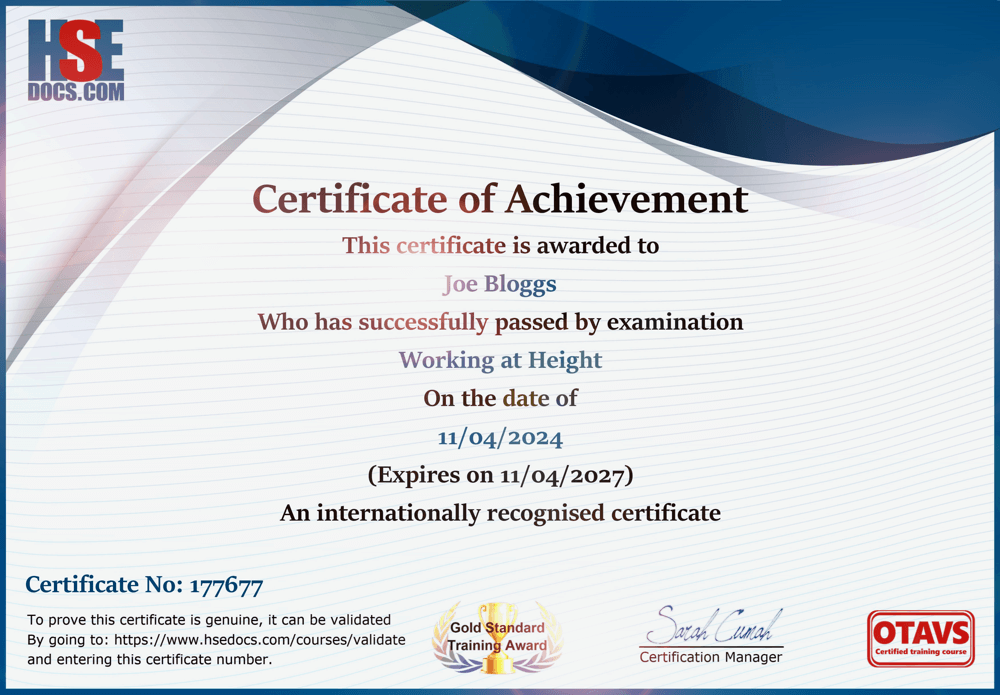Training for Food Hygiene Rating
Preparing you for an inspection and helping you improving your hygiene rating
Course certificate valid for 3 years
Internationally accredited training
HSEDocs offers this Food Hygiene Rating Training for food outlets seeking to achieve high food hygiene ratings or appeal against a low rating that has been awarded.
Achieving and maintaining high food hygiene standards can be a constant challenge for many establishments. This course is designed to help you address these issues and comply with current food hygiene standards. Various factors can complicate the process of consistently earning top ratings. Therefore, understanding these challenges and adopting effective strategies to address them is essential for ensuring compliance and enhancing customer satisfaction.
During an inspection, food safety officers assess several key areas to determine the rating. These include the overall cleanliness of the establishment, the methods used for preparing, storing, and handling food, as well as the effectiveness of management in upholding food safety standards. All of these factors are addressed in this informative short training course.
£9.99 for an individual course, £6.49 if you buy 10 or more, and just £4.99 for bulk orders of 50 or over.
This course is accredited and certified by OTAVS.
Online Training Accreditation & Verification Service
Course duration: Between 1 and 1 ½ hrs depending on learning speed.
Course format: Three video training modules, with a multiple-choice section at the end of each module.
Entry Requirements: Anyone can complete this course, whether they have previous experience or not.
All successful candidates are entered on the national training register, and certificates can be verified by employers or others to prove that they are genuine by clicking Validate a Certificate and typing in the certificate number.
Overview of HSEDocs Food Hygiene Awareness Course
Our Food Hygiene Awareness course covers the following:
- What Food Hygiene Ratings are
- Inspections
- Practices that help receive the best ratings
- The Benefits of High Food Hygiene Ratings
- Improving food hygiene standards
- Correct storage and handling
- How to Appeal Against a Food Hygiene Rating Decision
- Preparing An Appeal
- Submitting Your Appeal
- Awaiting the Outcome
- Steps After the Decision
Learning about food allergens is essential to protecting customers from products that could potentially cause them harm, even though most people consider the product safe. The need for allergen training and correct allergen labelling of foods was highlighted by the devastating tragedy bestowed on the Ednan-Laperouse family, which brought about Natashas Law.

If you feel that your rating is unfair, you may have the option to appeal the decision. Generally, you’ll need to submit your appeal within a specific timeframe, usually 21 days from when you received your rating. To navigate the appeal process, you will need to start by reaching out to your local authority. You will need to present your case clearly and gather any additional evidence that strengthens your claim. Being aware of these procedures is crucial for ensuring a fair reassessment of your rating. Begin the appeal by carefully reviewing the inspection report to pinpoint the reasons behind your rating. Identifying specific issues will allow you to build a solid case. Contact your local authority to obtain an appeal form or get guidance on the requirements for submission, including any necessary documents.
When presenting your case, it’s essential to be clear and to the point. Start by highlighting the specific areas where you believe the inspection fell short in terms of accuracy or fairness. To bolster your argument, gather supporting evidence such as updated cleaning logs, temperature records, staff training certificates, or photos showing the improvements or corrections made since the initial inspection. This evidence will be key in demonstrating your commitment to upholding high hygiene standards. You might also want to request a re-inspection, allowing the inspector to see the enhancements you’ve made firsthand. During this follow-up inspection, make sure all the concerns flagged in the first inspection have been thoroughly addressed. Engaging in open dialogue with the inspector is crucial to clear up any misunderstandings and provide additional context where needed. Keep in mind the importance of maintaining detailed records of all communications with the local authority throughout the appeal process. This will not only help you monitor the progress of your appeal but also serve as a valuable reference in case any disputes arise. Remember, patience and diligence are key; the appeal process can be lengthy and demands careful attention to detail.
A high food hygiene rating brings several benefits for both consumers and businesses alike. For consumers, an excellent rating signals that the establishment adheres to strict hygiene protocols, significantly minimising the risk of foodborne illnesses. From a business perspective, maintaining a high rating can provide a significant advantage. It not only attracts more customers but also fosters loyalty, as positive word-of-mouth and glowing online reviews can enhance a business's reputation, making it a preferred choice for diners. Moreover, a strong hygiene rating distinguishes a business in a crowded marketplace. Establishments that consistently uphold exceptional hygiene practices are often perceived as more reliable and trustworthy. Additionally, high hygiene ratings appeal to discerning customers who prioritize food safety and quality. These individuals are typically willing to pay a premium for the assurance of a safe dining experience, which can result in higher average spending per visit and improved revenue for the business. Investing in top hygiene standards also positively impacts management and operational practices. It demonstrates a commitment to excellence and showcases a proactive approach to maintaining a clean and safe environment. Furthermore, businesses with high ratings often experience smoother inspections and interactions with regulatory authorities. Companies that prioritise good hygiene practices generally encounter fewer compliance issues and undergo fewer inspections, allowing them to allocate valuable time and resources to other operations.

Contact Our Food Health & Safety Experts
We are always happy to help here at HSEDocs, so if you have any questions about allergen training, please give us a call.

 CART
CART 














